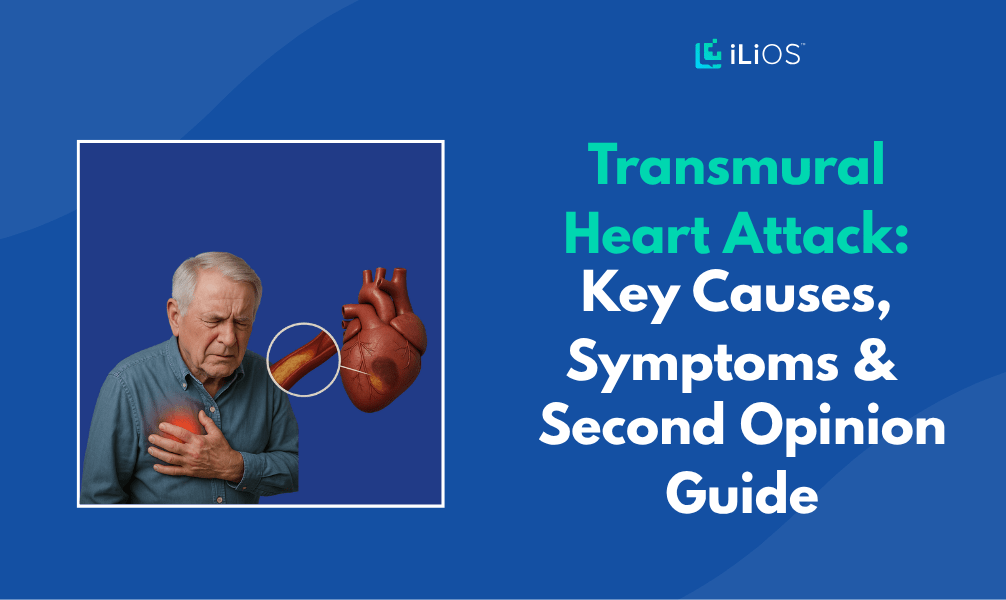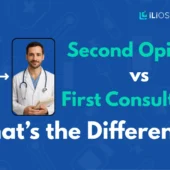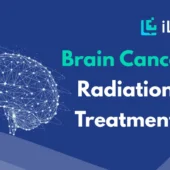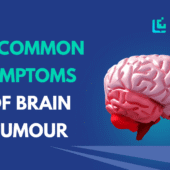A transmural heart attack, also referred to as STEMI (ST-Elevation Myocardial Infarction), is one of the most severe forms of heart attack. It occurs when the coronary artery is entirely blocked, which cuts off the blood supply across the complete thickness of the heart muscle wall. If this extensive injury is not addressed right away, it can lead to fatal complications.
Moreover, determining what causes a transmural heart attack, identifying early symptoms and seeking immediate medical care are essential for adequate recovery. Even after initial treatment, some patients may benefit from a second opinion for heart attack to make sure you undergo an accurate diagnosis, explore alternative treatments or confirm an ideal long-term care plan for their optimal health.
What is a Transmural Heart Attack?
A transmural heart attack is the most serious type of myocardial damage in which damage usually involves the full thickness of the heart muscle wall (endocardium, through the myocardium, to the epicardium). The only thing different is some consideration for subendocardial infarction, which only damages the actual inner “skin” of the heart muscle, as opposed to transmural infarction, which damages the entire wall.
Most commonly, transmural myocardial infarction occurs as a result of a complete and prolonged blockage of a coronary artery. This is often caused by the rupture of an atherosclerotic plaque within the artery, which leads to thrombus development. This type of heart attack is identified by ST-segment elevation on ECG and hence classified as ST elevation myocardial infarction (STEMI) – an indicator feature of full-thickness cardiac injury.
Among varied heart attack types, transmural is considered one of the most critical and life-threatening. This clot can impede blood flow even further, depriving the heart tissue of oxygen and nutrients. Plaque buildup or atherosclerosis in arteries, and rupturing to induce clotting, are common culprits of blood flow blockage. It needs urgent medical treatment to restore blood flow and minimize permanent damage to the muscle of the heart. However, delayed treatment can lead to complications like cardiogenic shock, heart failure or arrhythmias.
What are the Causes of STEMI?

STEMI (ST-Elevation Myocardial Infarction) is caused by the formation of blood clots in one of the coronary arteries and the blood vessels that supply oxygen-rich blood to the heart muscle. This clot can then block blood flow even further, causing the tissues at the heart to not receive oxygen and essential nutrients. The most common causes of blockers are the build-up of plaque or atherosclerosis of arteries that can rupture and cause a clot.
There are also other contributing factors to the development of a STEMI (ST-Elevation Myocardial Infarction):
-
High Cholesterol
-
High Blood Pressure
-
Diabetes
-
Obesity
-
Smoking
Moreover, determining these risks and making the right lifestyle changes at the right time can help you reduce the likelihood of experiencing STEMI (ST-Elevation Myocardial Infarction).
Key Symptoms of STEMI to Check In
STEMI (ST-Elevation Myocardial Infarction) is a medical emergency that typically occurs when there is a significant blockage in blood flow to the heart muscle, resulting in tissue damage. Key symptoms of STEMI (ST-Elevation Myocardial Infarction) that you must be aware of includes:
-
Chest Pain.
-
Discomfort radiating from arms, back, stomach, jaw and neck.
-
Nausea or Vomiting.
-
Shortness of breath.
-
Cold Sweats.
-
Feeling dizzy or Lightheaded.
Suppose you experience any of the above symptoms, especially chest pain that lasts more than a few minutes. In that case, it is essential to seek medical attention or online cardiologist consultation, as it can indicate STEMI (ST-Elevation Myocardial Infarction).
What is the Difference Between Transmural and Subendocardial Infarction?
Transmural infarction refers to a type of heart attack wherein damage extends through the full thickness of the heart muscle wall, from the endocardium to the epicardium. It is linked with full coronary artery blockage, which causes myocardial damage. ECG changes in transmural infarction demonstrate ST-segment elevation.
Whereas, subendocardial infarction includes the inner layer of the heart wall (subendocardium) and results from partial or temporary obstruction of the blood flow. It is considered less severe but causes serious complications. ECG changes in subendocardial infarction show ST-segment depression or T-wave inversion and are categorized as NSTEMI (Non-ST-Elevation Myocardial Infarction).
Essential Diagnosis of STEMI (ST-Elevation Myocardial Infarction)
STEMI is diagnosed using a combination of medical history, diagnostic testing, and a physical examination. Usually, healthcare providers perform an electrocardiogram (ECG) to evaluate the heart’s electrical activity and look for characteristic changes indicating a heart attack. Moreover, blood tests are conducted to measure cardiac enzymes to confirm an adequate diagnosis.
Moreover, professionals conduct tests like coronary angiography or echocardiography to visualize the extent of heart muscle damage and identify the blockage location. However, correct diagnosis is critical for commencing appropriate therapy and avoiding further difficulties.
What are the Ideal Treatment Options for STEMI?
The core goal of treating STEMI is to restore blood flow to the affected part of the heart muscle quickly, thereby preventing permanent damage. Standard treatment options include:
-
Coronary angioplasty and stenting to open the blocked arteries.
-
Medications include antiplatelet drugs, pain relievers, and blood thinners.
-
Cardiac rehabilitation programs to enhance heart health and minimize future event risks.
-
Thrombolytic therapy is used to dissolve various blood clots.
However, in some circumstances, surgery such as coronary artery bypass grafting (CABG) is advised to bypass blocked or restricted arteries and improve blood flow to the heart. Treatment depends on the individual’s condition, the extent of their heart damage and other medical-related factors.
When should you Seek a Second Opinion with STEMI?
-
Unclear Diagnosis or Conflicting Outcomes: If your test results, like angiography or ECG, are inconclusive or if different doctors suggest varying diagnoses, then looking for a cardiology second opinion can help you plan an ideal treatment option.
-
Before Undergoing Major Medical Process: When you are advised to undergo extensive treatments such as bypass surgery or angioplasty, a second opinion can confirm whether it is required or an alternative therapy can help you heal.
-
Persistent Symptoms After Treatment: If you still experience chest pain, breathlessness or fatigue after treatment, you must consult a specialist to reassess your recovery plan.
-
Current Multiple Health Conditions: For patients with other medical issues, such as bone-related conditions, obtaining an orthopaedic second opinion is essential to align cardiac recovery with rehabilitation and mobility needs.
-
Concerns with Neurologic Impact: If you face symptoms like memory issues or dizziness after a heart attack, then you must consider a neurology consultation online to treat brain-related complications.
Conclusion
A transmural heart attack is a life-threatening condition that demands prompt medical attention. Identifying its symptoms at the right time and determining causes is essential for timely intervention. However, if you are uncertain regarding the treatment plan, consult with our cardiology expert to gain expert guidance on your STEMI condition.
FAQs
1. When should I get a second opinion for a STEMI heart attack?
Look for a second opinion if treatment options look unclear, surgery is advised or if you are unsure of a recovery plan.
2. What causes a STEMI (ST-Elevation Myocardial Infarction)?
It is caused by full obstruction of the coronary artery as a result of a blood clot or plaque rupture.
3. Is recovery possible after a heart attack or STEMI?
Yes, with lifestyle changes, prompt care, and follow-up with a cardiologist, recovery is possible.






